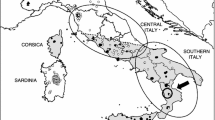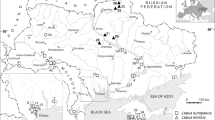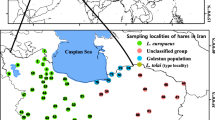Abstract
Although only of medium size, and thus of little nutritional value compared to big game such as mammoths and ungulates, hares (Lepus spp.) probably have always been a food source for humans, as documented in archaeological finds. Nowadays, hares, particularly such species as the brown hare (L. europaeus), are among the most important game species in many European countries. For hunting, perhaps religious reasons, and in connection with certain myths, hares have been and are still being intentionally translocated. Ancient translocations by humans can be inferred from the presence of hares on islands that had no mainland connections, at least during the Pleistocene, the major evolutionary period of the genus Lepus. We review some of the literature on anthropogenic translocations of hares. We focus on three examples [the brown hare (L. europaeus), the Corsican hare (L. corsicanus), and the Sardinian hare (L. capensis)], where some molecular data could be used to trace the translocation routes and possible origins of introduced hare populations. Certain molecular marker systems, such as sequences of the hypervariable part I (HV-1) of the mitochondrial control region, show high variability in hare species and are thus promising for tracing both recent and ancient origins of translocated hares. Some other molecular marker systems as well as caveats connected with the use of such marker systems in the genus Lepus are also discussed.

Similar content being viewed by others
References
Adovasio JM, Soffer O, Hyland DC, Illingworth JS, Klima B, Svoboda J (2001) Perishable industries from Dolní Vestonice I: new insights into the nature and origin of the Gravettian. Archaeol Ethnol Anthropol Eurasia 2:48–65
Alves PC, Ferrand N, Suchentrunk F, Harris DJ (2003) Ancient introgression of Lepus timidus mtDNA into L. granatensis and L. europaeus in the Iberian Peninsula. Mol Phylogenet Evol 27:70–80
Alves PC, Branco M, Suchentrunk F, Harris DJ (submitted) Evidence for the conspecificity of the European hares Lepus corsicanus and L. castroviejoi based on sequences from four independent loci. Mol Phylogenet Evol
Andersson A-C, Thulin C-G, Tegelström H (1999) Applicability of rabbit microsatellite primers for studies of hybridisation between an introduced and a native hare species. Hereditas 130:309–315
Angelici FM, Luiselli L (2001) Distribution and status of the Apennine hare Lepus corsicanus in continental Italy and Sicily. Oryx 35:245–249
Angermann R (1965) Revision der paläarktischen und äthiopischen Arten der Gattung Lepus (Leporidae, Lagomorpha). Dissertation thesis, Humboldt University, Berlin
Bar-Oz G, Dayan T, Kaufman D (1999) The Epipalaeolithic faunal sequence in Israel: a view from Neve David. J Archaeol Sci 26:67–82
Barton RNE, Jacobi RM, Stapert D, Street MJ (2003) The Late-glacial reoccupation of the British Isles and the Creswellian. J Quat Sci 18:631–643
Barton RNE, Bouzouggar A, Collcutt SN, Gale R, Higham TFG, Humphrey LT, Parfitt S, Rhodes E, Stringer CB, Malek F (2005) The Late Upper Palaeolithic occupation of the Moroccan Northwest Maghreb during the Last Glacial Maximum. Afr Archaeol Rev 22:77–100
Belfiore NM, Hoffman FG, Baker RJ, Dewoody JA (2003) The use of nuclear and mitochondrial single nucleotide polymorphisms to identify cryptic species. Mol Ecol 12:2011–2017
Ben Slimen H, Suchentrunk F, Shahin AB, Ben Ammar Elgaaied A (in press, a) Phylogenetic analysis of mtHV-1 sequences of Tunisian and Egyptian hares (Lepus sp. or spp., Lagomorpha) with different coat colours. Mamm Biol
Ben Slimen H, Suchentrunk F, Memmi A, Ben Ammar Elgaaeid A (2005, b) Biochemical genetic relationships among Tunisian hares (Lepus sp.), South African cape hares (L. capensis), and European brown hares (L. europaeus). Biochem Genet 43:577–596
Ben Slimen H, Suchentrunk F, Memmi A, Sert H, Kryger U, Alves PC, Ben Ammar Elgaaied A (2006, c) Evolutionary relationships among hares from North Africa (Lepus sp. or Lepus spp.), cape hares (L. capensis) from South Africa, and brown hares (L. europaeus), as inferred from mtDNA PCR-RFLP and allozyme data. J Zool Syst Evol Res 44:88–99
Blaxter KL (1975) Conventional and unconventional farmed animals. Proc Nutr Soc 34:51–56
Chakraborty R, Nei M (1977) Bottleneck effects on average heterozygosity and genetic distance with the stepwise mutation model. Evolution 31:347–356
Caloi L, Gliozzi E, Kotsakis T, Malatesta A, Palombo MR (1986) Observations on the paleobiogeography of Pleistocene mammals in Italy. Hystrix 1:7–23 (in Italian)
Corbet GB (1986) Relationships and origins of the European lagomorphs. Mamm Rev 16:105–110
Dermitzakis MD (1990) The colonization of the islands of the Aegean in relation to its paleogeographic evolution. Biol Gallo-Hell 17:99–130 (in Greek)
Ellerman JR, Morrison-Scott TCS (1951) Checklist of Palaearctic and Indian mammals 1758–1946, 2nd edn. British Museum (Natural History), London
Fickel J, Schmidt A, Putze M, Spittler H, Ludwig A, Streich WJ, Pitra C (2005) Genetic structure of populations of European brown hare: implications for management. J Wildl Manage 69:760–770
Fiore I, Gala M, Tagliacozzo A (2004) Ecology and subsistence strategies in the eastern Italian Alps during the Middle Palaeolithic. Int J Osteoarchaeol 14:273–286
Flux JEC (1990) Brown hare. In: King CM (ed) The handbook of New Zealand mammals. Oxford University Press, Auckland, pp 162–172
Flux JEC, Angermann R (1990) Hares and jackrabbits. In: Chapman JA, Flux JEC (eds) Rabbits, hares and pikas. Status survey and conservation action plan. IUCN/SSC Lagomorph Specialist Group, Gland, pp 61–94
Fraguglione D (1964) Introduction artificielle et tentative d’acclimatitation due lièvre commun (Lepus europaeus Pallas, 1778) (par le monde). Royal Saint Hubert Club Belgique, pp 1–16
Grigson C (1983) Mesolithic and neolithic animal bones. In: Evans JG, Smith IF (eds) Excavations at Cherhill, North Wiltshire, 1967. In: Proceedings of the Prehistoric Society 49, pp 64–72
Hirakawa H, Kuwahata T, Shibata Y, Yamada E (1992) Insular variation of the Japanese hare (Lepus brachyurus) on the Oki Islands, Japan. J Mammal 73:672–679
Hardy C, Vigne J-D, Casane D, Dennebouy N, Mounolou J-C, Monnerot M (1994) Origin of European rabbit (Oryctolagus cuniculus) in a Mediterranean island: zoolarchaeology and ancient DNA examination. J Evol Biol 7:217–226
Hartl GB, Suchentrunk F, Nadlinger K, Willing R (1993) An integrative analysis of genetic differentiation in the brown hare Lepus europaeus based on morphology, allozymes and mitochondrial DNA. Acta Theriol 38:33–57
Hartl GB, Willing R, Nadlinger K (1994) Allozymes in mammalian population genetics and systematics: indicative function of a marker system reconsidered. In: Schierwater B, Streit B, Wagner GP, DeSalle R (eds) Molecular ecology and evolution: approaches and applications. Birkhäuser, Basel, pp 299–310
Howell-Meurs S (2001) Archaeozoological evidence for pastoral systems and herd mobility: the remains from Sos Höyük and Büyüktepe Höyük. Int J Osteoarchaeol 11:321–328
Hockett B, Haws JA (2002) Taphonomic and methodological perspectives of Leporid hunting during the upper Paleolithic of the western Mediterranean Basin. J Archaeol Method Theory 9:269–302
Jones RL, Keen DH (1993) Pleistocene environments in the British Isles. Chapman and Hall, London
Kasapidis P, Suchentrunk F, Magoulas A, Kotoulas G (2005) The shaping of mitochondrial DNA phylogeographic patterns of the brown hare (Lepus europaeus) under the combinded influence of Late Pleistocene climatic fluctuations and anthropogenic translocations. Mol Phylogenet Evol 34:55–66
Kotsakis T (1986) Elementi di paleobiogeografica dei mammiferi terziari dell’Italia. Hystrix 1:25–68
Kumar S, Tamura K, Jakobsen I, Nei M (2001) MEGA2: molecular evolutionary genetics analysis software. Bioinformatics 17:1244–1245
Letty J, Hivert J, Quenny G, Aubineau J, Monnerot M, Marchandeau S (2002) Assessment of genetic introgression due to wild rabbit restocking. Z Jagdwiss 48(suppl):33–41
Lubell D (2001) Late Pleistocene–Early Holocene Maghreb. In: Peregrine PN, Ember M (eds) Encyclopedia of prehistory, volume 1: Africa. Kluwer Academic/Plenum Publishers, New York, pp 129–149
Mamuris Z, Sfougaris AI, Stamatis C (2001) Genetic structure of Greek brown hare (Lepus europaeus) populations as revealed by mtDBNA RFLP-PCR analysis: implications for conserving genetic diversity. Biol Conserv 101:187–196
Mamuris Z, Suchentrunk F, Stamatis C, Sfougaris AI, Giacometti M, Haerer G, Sert H, Davidovic M, Vukovic M, Vapa L, Tvrtkovic N, Erdogan A, Alves PC (2004) Phylogeography of European brown hares (Lepus europaeus). 2nd World Lagomorph Conference, 26–31 July 2004, Vairão, Portugal, abstract book, p 111
Manginis G, Karali L, Tsaliki A, Vavouranakis G (2001) An interdisciplinary approach towards burial practices in Prehistoric Bronze Age Cyprus: artifactual and osteological material from Audēmou-Kamares. British Association of Biological and Anthropological Osteology (BABAO). 3rd Ann. Conf., Univ. Durham, 14–15 July 2001
Melo-Ferreira J, Boursot P, Suchentrunk F, Ferrand N, Alves PC (2005) Invasion from the cold past: extensive introgression of mountain hare (Lepus timidus) mitochondrial DNA into three other hare species in northern Iberia. Mol Ecol 14:2459–2464
Miller GS Jr (1912) Catalogue of the mammals of Western Europe (Europe exclusive of Russia) in the collection of the British Museum. British Museum (Natural History), London
Mitchell-Jones AJ, Amori G, Bogdanowicz W, Kryštufek B, Reijnders PJH, Spitzenberger F, Stubbe M, Thissen JBM, Vohralík V, Zima J (1999) The Atlas of European Mammals. Academic Press, T. & A.D. Poyser Natural History, London
Musil R (1994) The fauna. In: Svoboda J (ed) Pavlov I, Excavations 1952–1953, ERAUL 66. Univ. de Liège, Liège, Belgium, pp 181–209
Nadlinger KF (1994) Restriktionsfragmentlängenpolymorphismus mitochondrialer DNA in Lepus europaeus, Cervus elaphus und Bison bonasus. PhD dissertation, University of Vienna
Palacios F, Orueta JF, Tapia GG (1989) Taxonomic review of the Lepus europaeus group in Italy and Corsica. Abstracts of papers and posters. V ITC, Rome, I:189–190
Palacios F (1996) Systematics of the indigenous hares of Italy traditionally identified as Lepus europaeus Pallas, 1778 (Mammalia: Lepordiae). Bonn Zool Beitr 46:59–91
Palacios F (1998) Diversity of hares in Europe. In: Reig S (ed) Abstracts Euro-American Mammal Congress, Santiago de Compostela, 19–24 July 1998. Universidade de Santiago de Compostela, Santiago de Compostela, Spain, p 85
Palacios F, Fernández J (1992) A new subspecies of hare from Majorca (Balearic Islands). Mammalia 56:71–85
Pierpaoli M, Riga F, Trocchi V, Randi E (1999) Species distinction and evolutionary relationships of the Italian hare (Lepus corsicanus) as described by mitochondrial DNA sequencing. Mol Ecol 8:1805–1817
Scalera R, Angelici FM (2002) Rediscovery of the Apennine hare Lepus corsicanus in Corsica. Museo Regionale Scientifico Nationale Bollettino (Turin) 20:161–166
Scandura M, Iacolina L, Ben Slimen H, Suchentrunk F, Apollonio M (in press) Mitochondrial CR-1 variation in Sardinian hares and its relationships with other Old World hares (genus Lepus). Biochem Genet
Sert H, Suchentrunk F, Erdoğan A (2005) Genetic diversity within Anatolian brown hares (Lepus europaeus Pallas, 1778) and differentiation among Anatolian and European populations. Mamm Biol 70:171–186
Stamatis C, Suchentrunk F, Giacometti M, Haerer G, Davidovic M, Vapa L, Vukovic M, Tvrtkovic N, Sert H, Mamuris Z (submitted) Phylogeography of the brown hare, Lepus europaeus, in Europe: a legacy of southeastern Mediterranean refugia?
Stewart AJ (1982) Pleistocene vertebrates in the British Isles. Longman, London and New York
Suchentrunk F, Jaschke C, Haiden A (2001) Little allozyme and mtDNA variability in brown hares (Lepus europaeus) from New Zealand and Britain – a legacy of bottlenecks? Mamm Biol 66:48–59
Suchentrunk F, Ben Slimen H, Sert H (in press) Phylogenetic aspects of nuclear and mitochondrial gene pool characteristics of South and North African cape hares (Lepus capensis) and European brown hares (L. europaeus). In: PC Alves, N Ferrand, K Hackländer (eds) Biology of Lagomorphs – Systematics, Ecology and Conservation. Springer, Berlin
Suchentrunk F, Mamuris Z, Stamatis C, Ben Slimen H, Hackländer K, Haerer G, Giacometti M. (2005) Introgressive hybridization in wild living mountain hares (Lepus timidus) and brown hares (L. europaeus) and morphological consequences. Mamm. Biol. 70 (suppl):39-40
Stiner MC (2001) Thirty years on the “Broad Spectrum Revolution” and paleolithic demography. Proc Natl Acad Sci 98:6993–6998
Tamura K, Nei M (1993) Estimation of the number of nucleotide substitutions in the control region of mitochondrial DNA in humans and chimpanzees. Mol Biol Evol 10:512–526
Templeton AR (1998) Nested clade analyses of phylogenetic data: testing hypothesis about gene flow and population history. Mol Ecol 7:381–397
Thompson JD, Gibson TJ, Plewniak F, Jeanmougin F, Higgins DG (1997) The ClustalX windows interface: flexible strategies for multiple sequence alignment aided by quality analysis tools. Nucleic Acids Res 24:4876–4882
Thulin C-G, Jaarola M, Tegelström H (1997) The occurrence of mountain hare mitochondrial DNA in wild brown hares. Mol Ecol 6:463–467
Trocchi V, Riga F, Randi E (2003) Lepus (“capensis”) mediterraneus Wagner, 1841-Sardischer Hase. In: F Krapp (ed) Handbuch der Säugetiere Europas. Aula Verlag, Wiebelsheim, pp 105–116
Vigne J-D (1983) Le remplacement des faunes de petits mammifères en Corse, lors de l’arrivé de l’homme. C R Seances Soc Biogeogr 59:41–51
Vigne J-D (1988) Les mammifères post-glaciaires de Corse: étude archéozoologique. Gallia Préhist 26(suppl):1–337
Waltari E, Cook JA (2005) Hares on ice: phylogeography and historical demographics of Lepus arcticus, L. othus, and L. timidus (Mammalia: Lagomorpha). Mol Ecol 14:3005--3016
Wilkens B (2003) Sardinia, Corsica et Baleares Antiquae. Int J Archaeol 1:181–197
Wilson DE, Reeder DM (2005) Mammal species of the world -- a taxonomic and geographic reference. 3rd edition, vol 1. J. Hopkins Univ. Press, Baltimore
Wu C, Wu J, Bunch TD, Li Q, Wang Y, Zang Y (2005) Molecular phylogenetics and biogeography of Lepus in Eastern Asia based on mitochondrial DNA sequences. Mol Phylogenet Evol 37:45--61
Yalden D (1999) The history of British mammals. T. & A.D. Poyser Natural History, Academic Press, London
Yang DY, Woiderski JR, Driver JC (2005) DNA analysis of archaeological rabbit remains from the American Southwest. J Archaeol Sci 32:567–578
Acknowledgment
We thank Mrs Anita Haiden for laboratory assistance.
Author information
Authors and Affiliations
Corresponding author
Rights and permissions
About this article
Cite this article
Suchentrunk, F., Ben Slimen, H., Stamatis, C. et al. Molecular Approaches Revealing Prehistoric, Historic, or Recent Translocations and Introductions of Hares (Genus Lepus) by Humans. Human Evolution 21, 151–165 (2006). https://doi.org/10.1007/s11598-006-9016-7
Received:
Accepted:
Published:
Issue Date:
DOI: https://doi.org/10.1007/s11598-006-9016-7




